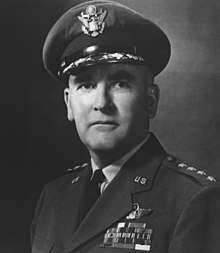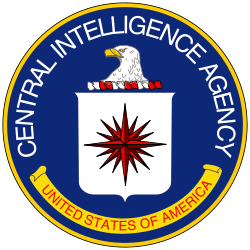Charles P. Cabell
| Charles P. Cabell | |
|---|---|
 General Charles P. Cabell | |
| Birth name | Charles Pearre Cabell |
| Born |
October 11, 1903 Dallas, Texas |
| Died |
May 25, 1971 (aged 67) Arlington, Virginia |
| Buried | Arlington National Cemetery |
| Allegiance |
|
| Service/ |
|
| Years of service | 1925-1962 |
| Rank |
|
| Battles/wars |
World War II Cold War |
| Awards |
Distinguished Service Medal (2) Legion of Merit Distinguished Flying Cross Bronze Star Air Medal (2) |
| Spouse(s) | Jacklyn DeHymel |
| Relations |
Ben E. Cabell (father) William L. Cabell (grandfather) Earle Cabell (brother) |
Charles Pearre Cabell (October 11, 1903 – May 25, 1971) was a United States Air Force General and Deputy Director of the Central Intelligence Agency (1953–1962).
Early life
He was the son of Ben E. (son of Confederate general William L. Cabell) and Sadie E. (Pearre) Cabell and attended Oak Cliff High School in Dallas, Texas. He graduated from West Point in 1925. He was initially commissioned as an artillery lieutenant and served in the field artillery until 1931, when he went to flying school, and was transferred to the Air Corps. He served in a variety of aviation roles as a staff officer and squadron commander throughout the pre-war years, primarily in observation and pursuit squadrons. His observation roles led naturally to his later involvement in photographic and intelligence roles.
Cabell achieved the rank of colonel in 1942 and brigadier general in 1944, serving both at air force headquarters at the Pentagon and in the European Theater. During the late 1940s and early 1950s, he held a variety of staff headquarters positions, including chief of Air Force Intelligence 1948-1951, and director of the staff for the Joint Chiefs of Staff from 1951-1953.
In 1949, Cabell set up Project Grudge to "make a study reviewing the UFO situation for AF HQ." However, Grudge quickly became all but moribund, while simultaneously reporting that all UFO cases were being closely investigated. When Cabell learned of this, he ordered Grudge dissolved and ordered that the "open minded"[1] Project Blue Book be created.
In November 1951, he was named director of the Joint Staff for the Joint Chiefs of Staff. During this time, he was promoted to Lieutenant General.
In 1952, he was an enthusiastic promoter of the U-2 spy plane, along with Allen Welsh Dulles and John Foster Dulles.
CIA career
On April 23, 1953, while still an active air force officer, he was appointed Deputy Director of the CIA under Allen Dulles. In 1956, along with the CIA's Richard Bissell, he flew to Bonn, to brief the West German Chancellor, Konrad Adenauer, on the U-2 program. Adenauer allowed U-2 planes, pilots, and support teams to be based at Wiesbaden. He was promoted to full general in 1958.
Cabell was forced to resign as Deputy Director by President Kennedy on January 31, 1962, following the failure of the Bay of Pigs Invasion.[2] Cabell's brother, Earle Cabell, was Mayor of Dallas when Kennedy visited that city and was assassinated, on November 22, 1963.[3]
Later life and death
General Cabell died in 1971, four years before his brother Earle.
Conspiracy theories
One hypothesis regarding the assassination of U.S. President John F. Kennedy, has to do with the so-called Renegade CIA Clique", where one attempts to implicate Cabell and several other CIA officials, including James Jesus Angleton and William King Harvey, as well as the "three tramps", and Cabell's brother Earle Cabell.[4]
During Jim Garrison's 1973 bribery trial, tape recordings from March 1971 revealed that Garrison considered publicly implicating Cabell of conspiracy in the assassination after learning he was the brother of the Dallas mayor.[5] Theorizing that a plot to kill the President was masterminded out of New Orleans in conjunction with the CIA with cooperation from the Dallas police department and city government, Garrison tasked his chief investigator, Pershing Gervais, of looking into the possibility that Cabell had stayed in the city's Fontainebleau Motel at the time of the assassination.[5] The Washington Post reported that there was no evidence that Gervais ever followed through with the request and that there was no further mention of Cabell in Garrison's investigation.[5]
Personal
Cabell was married to Jacklyn DeHymel in 1934; they had two sons, Charles P. Cabell, Jr. and Benjamin Cabell IV, and one daughter, Catharine C. Bennett. He left an autobiography "A Man of Intelligence: Memoirs of War, Peace and the CIA" published in 1997. His oldest son Charles was also an Air Force officer and West Point graduate (Class of 1958), achieving the rank of brigadier general.
He was a tenth-generation descendant of Pocahontas and a third cousin of Navy four-star admiral Richard H. Jackson.[6]
Career chronology
- Assigned to flight school in 1931 and subsequently as flight instructor; transferred to U.S. Army Air Corps.
- Transferred to Panama Canal Zone in late 1931 as adjutant of the 7th Observation Squadron; subsequently commanded 44th Observation, 24th Pursuit, and 74th Pursuit Squadrons in this area. Promoted Captain sometime during this period.
- Transferred to Randolph Field, Texas, as flight instructor in 1934 and subsequently served as post adjutant beginning in 1937.
- Detailed to Air Corps Tactical School at Maxwell Field, Alabama in 1938, graduating in 1939, then detailed to Command and General Staff College at Leavenworth, Kansas in 1939, graduating in 1940. Promoted Major sometime during this period.
- Assigned to Photographic unit at Wright Field, Ohio during 1940, and as an observer with the Royal Air Force; in April 1941, he was assigned to the Office of the Chief of the Air Corps as Chief of the Photographic Unit. Promoted Lieutenant Colonel sometime during this period.
- In February 1942, he was assigned as assistant executive for technical planning and coordination in the Office of the Chief of the Air Corps. Promoted Colonel.
- During the summer of 1943, he attended the first course of the Army and Navy Staff College.
- In late 1943, he was transferred to the Eighth Air Force and assumed command of the 45th Combat Bombardment Wing.
- In April 1944, he became director of plans for the U.S. Strategic Air Force in Europe, and later that year, as a Brigadier General, became director of operations and intelligence for the Mediterranean Air Forces.
- In May 1945, he was assigned to Air Force headquarters as chief of the Strategy and Policy Division.
- In December 1945, he was detailed to the United Nations Military Staff Committee where he held roles as deputy and chief U.S. Air Force delegate to the committee.
- In August 1947, he was promoted Major General and returned to Air Force headquarters serving in planning and intelligence roles and became director of Air Force Intelligence in May 1948.
Decorations and medals










Foreign awards


_-_ribbon_bar.png)

References
- ↑ Albert A. Harrison, Starstruck: Cosmic visions in science, religion, and folklore, p. 40, New York: Berghahn Books, 2007
- ↑ "Will Retire", The Washington Post, January 23, 1962, p. A2. "McCone Is Confirmed for C.I.A.; Fulbright Dissents in 71-12 Vote", New York Times, February 1, 1962, p. 9.
- ↑ "Gen. Charles Cabell Dies, Former CIA Deputy Director", The Washington Post, May 27, 1971, p. B7.
- ↑ Catchpole, Terry (January 17, 1992). "Nine JFK assassination theories". Entertainment. Retrieved August 31, 2017.
- 1 2 3 Kelso, Iris (September 16, 1973). "Garrison Planned To Link General To JFK Slaying" (PDF). The Washington Post. Washington, D.C. p. E 10. Retrieved June 21, 2017.
- ↑ Brown, Alexander (1895), The Cabells and Their Kin: A Memorial Volume of History, Biography, and Genealogy, Boston and New York: Houghton, Mifflin and Company, pp. 229–230, 457–458, 472–474
